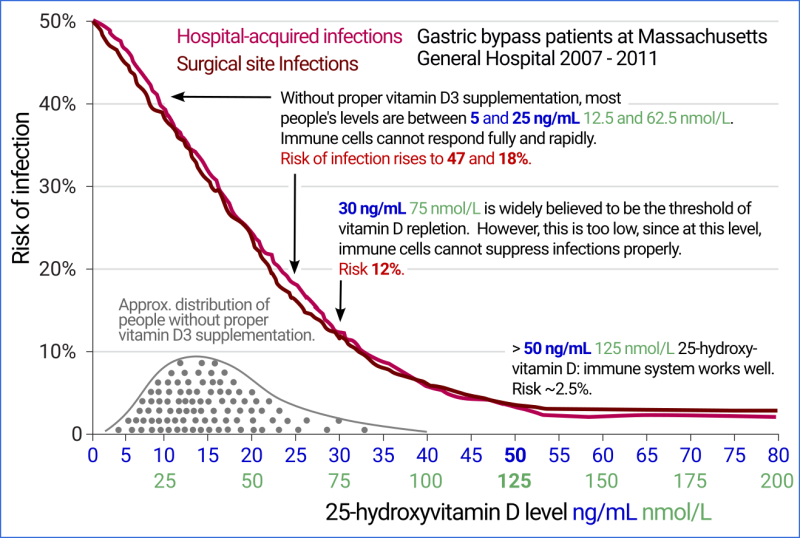Understanding Vitamin D and the Fast-Acting Calcifediol
The Significance of Vitamin D
Vitamin D is a fat-soluble vitamin that is essential for maintaining immune system function, mood regulation, and disease prevention.
Raising vitamin D levels isn’t an overnight endeavor. Typically, for someone deficient in Vitamin D, it could take months of regular supplementation to achieve blood levels above 50 ng/mL, a level often cited as optimal for overall health. However, its effectiveness is evident, as backed by many studies:
- A study from 2021 showed that 66% of subjects without skin cancer had vitamin D deficits, while only 34% with these types of skin cancers exhibited similar deficiencies.
- A meta-analysis from 2023 showed that higher Vitamin D intake and serum 25(OH)D levels were significantly linked to a reduced risk of cancer and a decrease in cancer-related mortality.
- In a systematic review and meta-analysis, it was found that COVID-19 mortality risk inversely correlates with Vitamin D3 status, suggesting that a mortality rate close to zero could theoretically be achieved at 50 ng/mL 25(OH)D3.
The 50 ng/mL Benchmark
There’s been a surge in literature hinting that individuals with vitamin D blood levels of 50 ng/mL or above generally maintain better health. This is backed by a study that showed that people who still living the lifestyle we evolved in, like the Maasai and Hadzabe, have average serum 25(OH)D concentrations of 119 nmol/l (47.6 ng/mL) and 109 nmol/l (43.6 ng/mL) respectively. Notably, individuals with Vitamin D bloodserum levels of higher than 50 ng/mL seem to exhibit resilience against many ailments, especially respiratory challenges. The mantra seems to be clear: adequate vitamin D could be a shield against several health adversities.

Enter Calcifediol
While Vitamin D supplementation, specifically Vitamin D3 cholecalciferol, is widely recognized and either ingested or produced in the skin via the action of UV-B light, there’s an alternative that’s gaining traction: calcifediol.
Calcifediol, also known as calcidiol, is a prehormone metabolized from Vitamin D3, predominantly in the liver. Its distinction lies in its bioavailability. Unlike regular Vitamin D3 in the form of cholecalciferol, calcifediol is highly bioavailable, meaning the body can use it more directly and effectively.
This efficacy allows calcifediol to rapidly raise vitamin D blood levels, achieving results in mere hours instead of the months typically associated with Vitamin D3 supplementation. This property proves invaluable, especially in situations where an accelerated immune response is desired. Regarding dosages, they often vary based on individual factors, but a common guideline is in the realm of milligrams per kilogram of body weight to quickly hit that desired 50 ng/mL benchmark.
Raising Calcifediol Levels in Clinical Emergencies
Although 5,000 IU may seem like a substantial amount of vitamin D3, this minuscule 1/8000th of a gram does little in a single day to elevate unsupplemented average 25-hydroxyvitamin D levels, which typically range from 5 to 25 ng/mL. A common method for rapidly increasing 25-hydroxyvitamin D levels is an oral bolus (or “loading”) dose of vitamin D3.
According to the European Society for Clinical Nutrition and Metabolism (ESPEN) Guideline on clinical nutrition in the intensive care unit, a single high dose of 500,000 IU (12.5 mg) of vitamin D3 appears safe for patients with deficiency during the first week of treatment, especially when taken in conjunction with Vitamin K2-MK7. However, in critically ill patients, potential limitations on absorption and on liver function, and the four or so days it takes to hydroxylate the vitamin D3 into 25-hydroxyvitamin D, unacceptably delay the urgently needed improvement in immune function.
Dosing of Calcifediol
A more effective approach involves a single oral dose of calcifediol (25-hydroxyvitamin D) of 0.014 mg per kilogram body weight. For an average weight adult, this is approximately 1 milligram. Calcifediol is more readily absorbed than vitamin D3 and directly enters circulation, safely elevating levels above 50 ng/mL within just 4 hours. This boosted level decreases over days to a week, so further calcifediol or regular or bolus vitamin D3 supplementation is necessary to maintain it. A 1 mg dose of calcifediol is roughly equivalent to a modest 160,000 IU (4 mg) of vitamin D3. Unless there is reason to suspect the patient has excessive 25-hydroxyvitamin D, blood tests are unnecessary, as this intake does not lead to toxicity.
In patients hospitalized with COVID-19, for instance, calcifediol treatment notably decreased the need for ICU admission and slashed the risk of death by 79.0% (RR 0.21, p = 0.001).
Consistency is Key
Like all good things, maintaining optimum levels of Vitamin D requires consistency. It’s not just about reaching the 50 ng/mL threshold; it’s about staying above. Regular intake ensures that serum levels remain steady, offering the body the full range of Vitamin D’s benefits.
While on the topic of supplementation, it’s worth noting the synergistic importance of Vitamin K2 and Magnesium. Vitamin K2 ensures that calcium is directed to the bones and not the arteries, while Magnesium aids in the activation of Vitamin D in the body. Together, they form a trinity of sorts, promoting overall health and well-being. Sunfluencer SUN, for instance, contains both Magnesium and Vitamin K2-MK7.
In conclusion, as we navigate through health literature and evolving science, Vitamin D, especially in its swift-acting form calcifediol, emerges as a potent ally. Armed with this knowledge and the right supplementation strategy, we’re poised to harness the full potential of this ‘sunshine vitamin’. Remember, health is a journey, not a destination. It’s the small, informed choices that lead to big results.
Reposted from: https://sunfluencer.com/understanding-vitamin-d-and-calcifediol/



.png)
.png)
.png)



Comments
Post a Comment